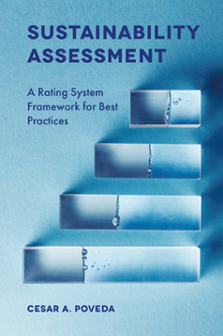
Afterword
ISBN: 978-1-78743-482-0, eISBN: 978-1-78743-481-3
Publication date: 10 October 2017
Citation
Poveda, C.A. (2017), "Afterword", Sustainability Assessment, Emerald Publishing Limited, Leeds, pp. 443-444. https://doi.org/10.1108/978-1-78743-481-320171023
Publisher
:Emerald Publishing Limited
Copyright © 2017 Emerald Publishing Limited
The different benefits have been studied to develop the Wa-Pa-Su project sustainability rating system framework to measure in a consistent manner the design and implementation of sustainable development strategies in projects with complex life cycles (e.g. oil & gas, energy, heavy industrial, mining). The rating system framework is a decision-making tool that can be adapted and used by companies, stakeholders and policy makers to measure and understand the range of impacts that the projects may have over time. This textbook has presented a description of the different components of the rating system, including the structure, the sustainable development indicators (SDIs) pre-selection process, the credit weighting tool (CWT) and the credit and overall sustainability assessment score allocation methodology. The textbook has also presented a theoretical adaptation and application of the assessment methodology to the surface mining recovery process for the development and operation of oil sands projects.
The exploration and exploitation of the oil sands resources is strategic development not only for Canada but also the world. As global demand for energy continues to rise, unconventional petroleum extraction and production of petroleum substitutes are both becoming more necessary. Development and operation of unconventional oil projects can have considerable social, economic and environmental impacts. The Athabasca oil sands in northern Alberta is one of the largest unconventional oil deposits in the world. Government policy makers, industrial developers and other stakeholders generally work together to develop oil sands projects in an environmentally responsible manner; however, the projects lack an effective sustainable development (SD) measurement tool.
The development of the oil sands has been shaped by different circumstances (e.g. politics, economics, social) throughout the years. As the development continues, concerns related to the projects’ sustainability increase. Developing companies, stakeholders and society are increasingly interested in understanding the impact that the projects have on present and future generations. Government agencies have issued a series of legal requirements (e.g. regulations) as an attempt to mitigate the impact of the projects. While these provide a general guideline to assist the decision-making processes at the senior and corporate levels, they barely assist practitioners and developing companies to accomplish the goals of sustainability in its three fundamentals pillars: social, economic and environmental. Consequently, the idea of developing an ESRS framework to measure the progress towards sustainability in complex environments makes perfect sense.
- Prelims
- Part I Sustainability Assessment
- Chapter 1 Assessment Approaches, Frameworks and Other Tools
- Chapter 2 Environmental and Sustainability Rating Systems
- Chapter 3 Potential Benefits of Developing and Implementing Environmental and Sustainability Rating Systems
- Part II A New Sustainability Rating System
- Chapter 4 Origins and Fundamentals
- Chapter 5 The Wa-Pa-Su Project Sustainability Rating System
- Part III The Canadian Oil Sands
- Chapter 6 Background and Processes
- Chapter 7 Impacts of Development and Operations
- Chapter 8 Resources Management and Performance: A Report
- Part IV An Application Step By Step: The Surface Mining Process
- Chapter 9 Areas of Excellence and Sub-Divisions
- Chapter 10 Identifying Sustainable Development Indicators (SDIs)
- Chapter 11 Designing and Implementing SDIs: More of a Positive Thing than Not
- Chapter 12 Weighting SDIs Using the AHP Method
- Chapter 13 Design of Performance Improvement Factors (PIFs)
- Chapter 14 A Simulated Case Study of Implementation and Sustainability Assessment
- Appendix A: Abbreviations and Acronyms
- Appendix B: Timeline of the Energy Industry in Alberta
- Appendix C: Descriptions – Pre-Selected Sustainable Development Indicators (SDIs) for the Surface Mining Process
- Afterword
- Index